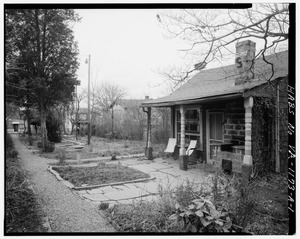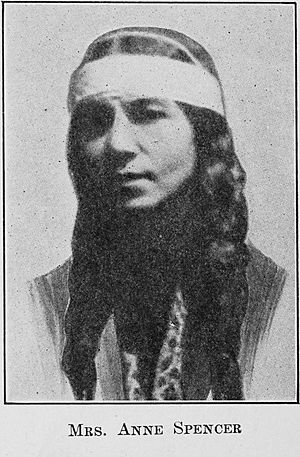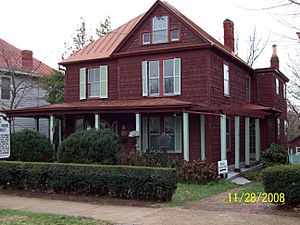Anne Spencer facts for kids
Quick facts for kids
Anne Spencer
|
|
|---|---|

Anne Bethel Spencer in her wedding dress, 1900
|
|
| Born | Annie Bethel Bannister February 6, 1882 Henry County, Virginia |
| Died | July 27, 1975 (aged 93) Lynchburg, Virginia |
| Alma mater | Virginia Seminary |
| Genre | poetry |
| Literary movement | Harlem Renaissance |
Anne Bethel Spencer (born Bannister; February 6, 1882 – July 27, 1975) was an American poet, teacher, and civil rights activist. She was also a librarian and loved gardening. Even though she lived in Lynchburg, Virginia, far from New York City, she was an important part of the Harlem Renaissance. This was a time when African American artists, writers, and thinkers created amazing works.
Anne Spencer met her husband, Edward Spencer, at Virginia Seminary. After they married in 1901, they moved into a house he built. They lived there their whole lives and raised their family. Their home became a special place where many famous people visited. These guests included Langston Hughes, Marian Anderson, George Washington Carver, and Martin Luther King Jr..
Anne Spencer was a very important poet. She was the first person from Virginia and one of only three African American women to be in a famous poetry book called Norton Anthology of Modern Poetry. She also worked for civil rights. She and her husband helped restart the NAACP group in Lynchburg. This group worked for equal rights and better education for everyone. Anne also loved her garden. Her husband built a small writing studio for her in the garden. She called it Edankraal, combining their names, Edward and Anne, with an African word for "enclosure."
Life Story
Growing Up
Annie Bethel Bannister was born in Henry County, Virginia, in 1882. Her parents, Joel and Sarah, wanted a better life for her. They had both worked on a plantation. Her father, Joel, was born into slavery in 1862. But Anne was part of the first generation of African Americans born after slavery ended.
Anne was an only child and her parents loved her very much. However, they disagreed about how to raise her and separated. After this, Annie used her mother's maiden name, Scales. She and her mother moved to Bramwell, West Virginia. This town was unusual because it welcomed African Americans and immigrants.
In Bramwell, Annie lived with the Dixie family. Her mother worked as a cook nearby. The Dixie family was well-known in the African American community. Annie didn't have to do chores or go to school, unlike the Dixie children. Her mother believed the local schools were not good enough for her.
This freedom helped Annie become a poet. She spent a lot of time exploring nature. She also found quiet time in the family outhouse. There, she would look at the Sears catalog. Even though she couldn't read yet, she imagined stories from the pages. This quiet time was very important for her future as a writer. Later in life, her garden studio, Edankraal, gave her a similar peaceful space.
School Days
Annie's parents stayed in touch about her. When her father learned she wasn't in school, he said she must go. Her mother had heard about the Virginia Seminary in Lynchburg. So, in 1893, at age 11, Annie was sent there.
Even though she hadn't gone to school much before, Annie did very well. She gave the main speech at her graduation in 1899. After graduating, she taught school in West Virginia for two years.
Adult Life and Family
While at the Virginia Seminary, Annie met Charles Edward Spencer. They married in 1901. In 1903, the Spencers moved to Lynchburg for good. They built their home at 1313 Pierce Street.
They had three children: two daughters, Bethel and Alroy, and a son, Chauncey Spencer. Chauncey continued his mother's work for civil rights. He played a big part in the military during World War II. His efforts helped create the Tuskegee Airmen. These were African American pilots who were first not allowed to fly for the military.
Later, Anne Spencer worked as a librarian at Paul Laurence Dunbar High School. She started this job in 1923 when her children went to college. She worked there for over 20 years. The library had few books, so Anne brought many from her own home collection.
Writing Life
Anne Spencer started writing poetry when she was a student. Her first poem, "the Skeptic," is now lost. She wrote poems throughout her life, often on any paper she could find. Her poems talked about race, nature, and the tough parts of life. Her work became very well-known.
Her career as a poet really began in 1919. She was helping to open an NAACP group in Lynchburg. James Weldon Johnson, a famous writer, visited her home for this. He discovered her poems during his visit. Through his editor, Anne's first poem, "Before the Feast at Shushan," was published. It appeared in The Crisis magazine in February 1920. She was 40 years old at the time.
Most of Anne Spencer's poems were published in the 1920s. This was during the Harlem Renaissance. Her work was highly respected. Her poems explored themes of race, nature, and women's rights. For example, her poem "White Things" is seen as comparing the struggles of black people to the harm done to nature.
Her work was in famous books like The New Negro: An Interpretation by Alain Locke. This book connected her to the Harlem Renaissance, even though she lived far from New York. Her poems were also in The Book of American Negro Poetry, edited by James Weldon Johnson. During her life, Anne Spencer published over 30 poems. She was only the second African American to be in the important Norton Anthology of American Poetry. After she passed away in 1975, more of her work was published.
Her Legacy
Anne Spencer passed away on July 27, 1975, at 93 years old. She is buried next to her husband, Edward, in Lynchburg. In 2016, she was honored as one of Virginia's "Strong Men and Women."
The house where Anne Spencer lived and wrote is now a museum. It is called the Anne Spencer House and Garden Museum. The museum helps keep her memory alive and shows her connection to the Harlem Renaissance. Anne was a famous gardener. Her garden was a big part of her life and inspired many of her poems. The small garden house, Edankraal, where she wrote, is also part of the museum.
Anne Spencer's writings and family papers are kept at the University of Virginia. Some of her letters with James Weldon Johnson are at Yale University. Her poetry often used her garden and plants as symbols. One of her most important poems was "White Things." Even though it wasn't reprinted much, it was seen as a powerful "protest" poem. Anne Spencer continued writing until she died. She even wrote a poem titled "1975" in the year she passed away.
In 2019, the United States Postal Service announced that Anne Spencer would be on a special postage stamp. This stamp honored important figures of the Harlem Renaissance. Other people on these stamps included writer Alain Locke and novelist Nella Larsen.




